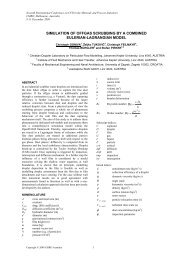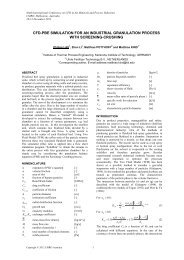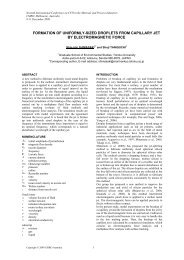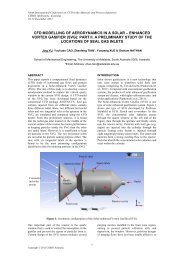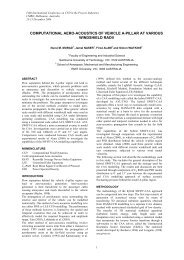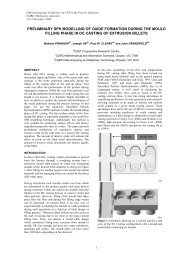dimensional numerical simulation of blood flow in mouse ... - CFD
dimensional numerical simulation of blood flow in mouse ... - CFD
dimensional numerical simulation of blood flow in mouse ... - CFD
You also want an ePaper? Increase the reach of your titles
YUMPU automatically turns print PDFs into web optimized ePapers that Google loves.
CONCLUSION<br />
This study is a first step <strong>in</strong> understand<strong>in</strong>g the effect <strong>of</strong><br />
hemodynamic parameters on plaque formation and<br />
development under realistic conditions.<br />
In this article, we have successfully applied an approach<br />
that permits the calculation <strong>of</strong> the <strong>blood</strong> <strong>flow</strong> <strong>in</strong> complex<br />
real artery geometries <strong>in</strong> the presence <strong>of</strong> plaques. The<br />
method <strong>of</strong> remov<strong>in</strong>g the plaque <strong>numerical</strong>ly to study the<br />
formation and the development <strong>of</strong> the plaque <strong>in</strong> the same<br />
artery predicts correctly the formation sites around local<br />
m<strong>in</strong>imum wall shear stress. In addition, we report that<br />
plaque development appears to be <strong>in</strong> the direction <strong>of</strong> the<br />
smallest gradient <strong>of</strong> wall shear stress, not only downstream<br />
the formation sites as suggested <strong>in</strong> the literature.<br />
ACKNOWLEDGEMENTS<br />
This work was supported by the Multi-modal Australian<br />
ScienceS Imag<strong>in</strong>g and Visualisation Environment<br />
(MASSIVE) (www.massive.org.au). The authors<br />
acknowledge f<strong>in</strong>ancial support from the Australian<br />
Research Council, under grant no. DP110100434.<br />
REFERENCES<br />
AVGERINOS, E.D., GIANNAKOPOULOS, T.G.,<br />
KADOGLOU, N.P., LIAPIS, C.D., MOULAKAKIS, K.G.<br />
and PAPAPETROU, A., (2011), “Biomarkers for<br />
diagnosis <strong>of</strong> the vulnerable atherosclerotic plaque.”,<br />
Interventional Cardiology, 3(2),223.<br />
BOND, A.R and C. L. JACKSON, (2011), “The fat-fed<br />
Apolipoprote<strong>in</strong> E Knockout <strong>mouse</strong> brachiocephalic artery<br />
<strong>in</strong> the study <strong>of</strong> atherosclerotic plaque rupture.”, J. Biomed.<br />
Biotechnol, 2011, 379069.<br />
CARO, C.G., FITZ-GERALD, J.M. and SCHROTER,<br />
R.C., (1971), “Atheroma and Arterial wall shear.<br />
Observation, correlation and proposal <strong>of</strong> a shear<br />
dependent mass transfer mechanism for atherogenesis.”, P.<br />
R. Soc. London, 177(1046), 109-133.<br />
CHATZIZISIS, Y.S., COSKUN, A.U., JONAS, M.,<br />
EDELMAN, E.R., FELDMAN, C.L. and STONE, P.H.,<br />
(2007), “Role <strong>of</strong> endothelial shear stress <strong>in</strong> the natural<br />
history <strong>of</strong> coronary atherosclerosis and vascular<br />
remodell<strong>in</strong>g: molecular, cellular, and vascular behaviour.”<br />
J. Am. Coll. Cardiol., 49(25), 2379-2393.<br />
CHENG, C., TEMPEL, D., VAN HAPEREN, R., VAN<br />
DER BANN, A., GROSVELD, F., DAEMEN M.J.,<br />
KRAMS, R. and DE CROM R., (2006), “Atherosclerotic<br />
lesion size and vulnerability are determ<strong>in</strong>ed by patterns <strong>of</strong><br />
fluid shear stress.”, J. Am. Heart Assoc., 113, 2744-2753.<br />
DEPAOLA, N., GIMBORNE, MA., DAVIS, J.F., and<br />
DEWEY, F., (1991), “Vascular endothelium responds to<br />
fluid shear stress gradients”. Atherosclerosis and<br />
Thrombosis, 12, 1254-1257.<br />
GIBSON, C.M., DIAZ, L., KANDARPA, K., SACKS,<br />
F.M., PASTERNAK, R.C., SANDOR, T., FELDMAN, C.<br />
and STONE, P.H., (1993), “Relation <strong>of</strong> vessel wall shear<br />
stress to atherosclerosis progression <strong>in</strong> human coronary<br />
arteries.”, J. Am. Heart Assoc., 13, 210-315.<br />
GROEN, H.C., GIJSEN, F.J.H., VAN DER LUGT, A.,<br />
HATSUKAMI, T.S., VAN DER STEEN, A.F.W., YUAN<br />
, C. and WENTZEL, J.J., (2007), “ Plaque Rupture <strong>in</strong> the<br />
Carotid Artery Is Localized at the High Shear Stress<br />
Region.”, Stroke, 38: 2379-2381.<br />
GUREYEV, T.E, NESTERETS, Y., TERNOVSKI, D.,<br />
THOMPSON, D., WILKINS, S. W., STEVENSON, A.<br />
Copyright © 2012 CSIRO Australia 6<br />
W., SAKELLARIOU, A. and TAYLOR J.A, (2011),<br />
“Toolbox for advanced X-ray image process<strong>in</strong>g,” Proc.<br />
SPIE 8141, 81410B, 81410B-14.<br />
HUO, Y., GUO, X. and KASSAB, G.S., (2008), “The<br />
<strong>flow</strong> field along the entire length <strong>of</strong> the <strong>mouse</strong> aorta and<br />
primary branches.”, Ann. Biomed. Eng., 36(5), 685-699.<br />
MICHELL, D. L., ANDREWS, K. L., WOOLLARD, K.<br />
J. and CHIN-DUSTING, J. P., (2011), “Imag<strong>in</strong>g leukocyte<br />
adhesion to the vascular endothelium at high <strong>in</strong>tralum<strong>in</strong>al<br />
pressure.”, J. Vis. Exp., 54, e3221.<br />
OLGAC, U., POULIKAKOS, D., SAUR, S.C.,<br />
ALKADHI, H. and KURTCUOGLU, V., (2009), “<br />
Patient-specific three-<strong>dimensional</strong> <strong>simulation</strong> <strong>of</strong> LDL<br />
accumulation <strong>in</strong> a human left coronary artery <strong>in</strong> its healthy<br />
and atherosclerotic states.”, Am. J. Physiol. Heart Circ.<br />
Physiol., 296,969-982.<br />
PAGANIN. D.P., MAYO, S.C., GUREYEV, T.E.,<br />
MILLER, P.R. and WILKINS S.W., (2002),<br />
“Simultaneous phase and amplitude extraction from a<br />
s<strong>in</strong>gle defocused image <strong>of</strong> a homogeneous object.”, J.<br />
Microscopy, 206(1), 33-40.<br />
PELLO, O.M., SILVESTRE, C., PIZZOL, M.D. and<br />
ANDRES, V., (2011), “A glimpse on the phenomenon <strong>of</strong><br />
macrophage polarization dur<strong>in</strong>g atherosclerosis.”,<br />
Immunobiology, 216,1172-1176.<br />
REININGER, A.J., BERNLOCHNER, I., PENZ, S.M.,<br />
RAVANAT, C., SMETHURST, P., FARNDALE R, W.,<br />
GACHET, C., BRANDL, R. and SIESS, W., (2010), “A<br />
2-Step Mechanism <strong>of</strong> Arterial Thrombus Formation<br />
Induced by Human Atherosclerotic Plaques.”, J. Am. Coll.<br />
Cardiol., 55(11), 1147-1158.<br />
SADAT , U., TENG. Z. and GILLARD, J.H., (2010),<br />
“Biomechanical structural stresses <strong>of</strong> atherosclerotic<br />
plaques.”, Expert Rev. <strong>of</strong> Cardiovasc. Therapy, 8(10):<br />
1469-1481.<br />
STANGEBY, D.K. and ETHIER, C.R., (2002),<br />
“Computational analysis <strong>of</strong> coupled <strong>blood</strong>-wall arterial<br />
LDL transport.”, T. ASME, 124, 1-8.<br />
STONE, P.H., COSKUN, A.U., KINLAY, S., POPMA,<br />
J.J., SONKA, M., WAHLE, A., YEGHIAZARIANS, Y.,<br />
MAYNARD, C., KUNTZ, R.E. and FELDMAN, C.L.,<br />
(2007), “Regions <strong>of</strong> low endothelial shear stress are the<br />
sites where coronary plaque progresses and vascular<br />
remodell<strong>in</strong>g occurs <strong>in</strong> humans: and <strong>in</strong> vivo serial study.”,<br />
Eur. Heart J., 28,705-710.<br />
TANG, D., TENG, Z., CANTON, G., YANG, C.,<br />
FERGUSON, M., HUANG, X., ZHENG, J., WOODARD,<br />
P.K. and YUAN, C., (2009), “Sites <strong>of</strong> rupture <strong>in</strong> human<br />
atherosclerotic carotid plaques are associated with high<br />
structural stresses: an <strong>in</strong> vivo mri-based 3d fluid-structure<br />
<strong>in</strong>teraction study.”, Stroke, 40: 3258-3263.<br />
TRACHET, B., SWILLENS, A., VAN LOO, D.,<br />
CASTELEYN, C., DE PAEPE, A., LOEYS, B. and<br />
SEGERS P., (2009), “The <strong>in</strong>fluence <strong>of</strong> aortic dimensions<br />
on calculated wall shear stress <strong>in</strong> the <strong>mouse</strong> aortic arch.”,<br />
Comput. Method Biomec., 12, 491-499.<br />
WELLS. R.E., MERRIL, J.W. and MERRILL, E.W.,<br />
(1961), “Shear rate dependence <strong>of</strong> the viscosity <strong>of</strong> whole<br />
<strong>blood</strong> and plasma.”, Science, 133(3455), 763-764.



